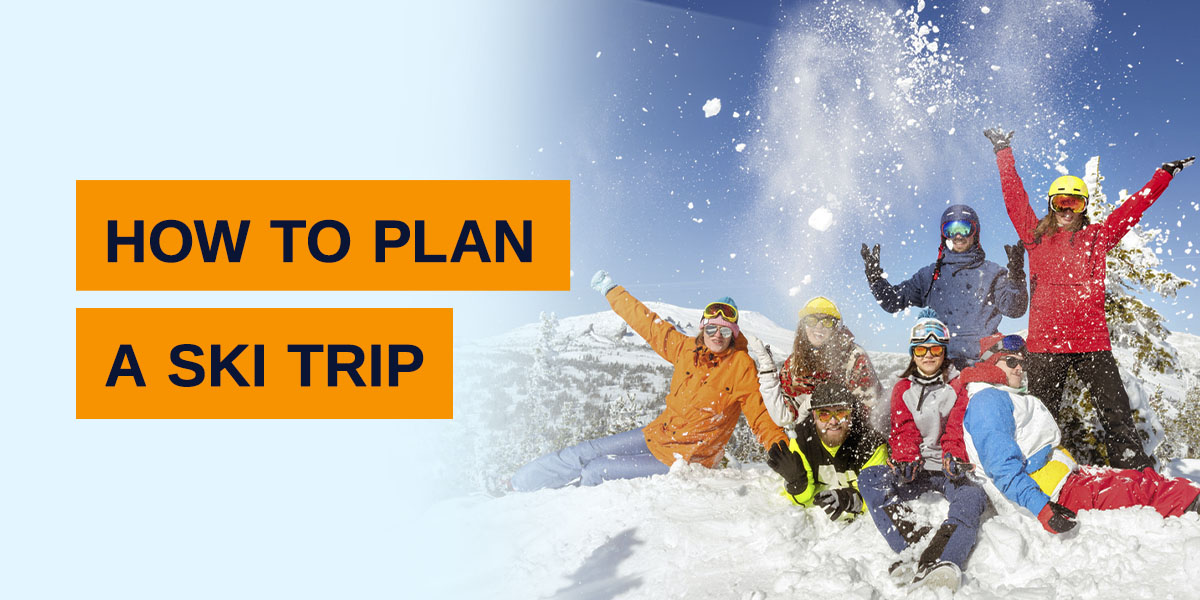 How to Plan a Ski Trip
How to Plan a Ski Trip
How to Plan a Ski Trip
Posted
by
Matt Gahman
on Friday, February 16, 2024
Nothing compares to the exhilarating feelings and breathtaking views you experience on a ski trip, and you can plan your ski trip with this ultimate guide. Equipped with our advice and ski trip checklists, you'll have a successful and memorable time with family and friends.
Find the Perfect Destination
The first part of ski trip planning involves deciding on the location. Consider the options in your chosen destination, look at reviews and go over the factors covered below to choose the best one.
Top Ski Locations in Pennsylvania
Pennsylvania has a wide selection of ski resorts. We've organized a few popular resorts below, but you can read our full skiing location guide for more options and in-depth information:
- Shawnee Mountain Ski Area: Located in East Stroudsburg, this resort boasts 23 trails and is perfect for beginners and families. There are also intermediate and advanced slopes with a vertical of 700 feet.
- Seven Springs Mountain Resort: Seven Springs is the biggest ski resort in Pennsylvania, with 33 trails, seven terrain parks and a peak mountain elevation of 2,994 feet. This resort is great for beginner and intermediate skiers, but there are some advanced slopes.
- Montage Mountain: Located in Scranton, this resort features 27 trails, a professional ski school, night skiing and a vertical of 1,000 feet. Montage Mountain is great for intermediate and advanced skiers, and there are some beginner slopes, too.
- Hidden Valley Resort: This resort has 26 trails and boasts 110 acres of skiable terrain. It's suitable for families and offers challenges for intermediate and advanced skiers.
- Blue Knob All Seasons Resort: Located in Claysburg, Blue Knob has 34 trails, a vertical drop of 1,072 feet and some of the most challenging slopes in Pennsylvania.
- Blue Mountain Resort: This resort in Palmerton has 40 trails for skiers of all levels and one of the highest verticals in the state at 1,082 feet.
- Camelback Resort: Located in Tannersville, Camelback Resort has 39 trails, multiple terrain parks and a vertical of 800 feet. You can also check out the waterpark while you're there!
- Elk Mountain: Elk Mountain in Union Town has 27 trails, and they have an advanced snow-making system to create optimal conditions.
Factors to Consider When Selecting a Ski Resort
When choosing a ski resort, consider the following:
- Resort costs: If your budget is limited, choose a ski resort closer to home to reduce travel costs. Take a look at the resort's accommodations, too. Staying in a fancy resort close to the slopes is worthwhile but can be expensive. Staying in a nearby hotel and traveling to the resort by car or shuttle is sometimes more affordable.
- Lodging preferences: Ski resorts have various lodging options, from luxury hotel rooms to condos and chalets. If you're planning a group ski trip, a chalet or mountain home may be a good option. If convenience and experience are important to you and you have the budget for it, stay at a resort with "ski-in-ski-out" lodging. Your room will be right next to the slopes!
- Proximity to cities or airports: If you want to save on accommodation costs or are interested in doing other activities outside of skiing, choose a ski resort close to a town or city. If you're traveling by plane, look for a ski resort near an airport. This isn't as much of a consideration if you're taking a road trip and spending all your time at the resort.
- Terrain variety: If you and your friends are beginners, choose a resort with groomed terrain so it's easier to learn. If you know what you're doing and want to try out different terrain types, choose a resort with lots of options. For those interested in performing tricks, you'll need a resort with terrain parks that have rails, jumps and obstacles.
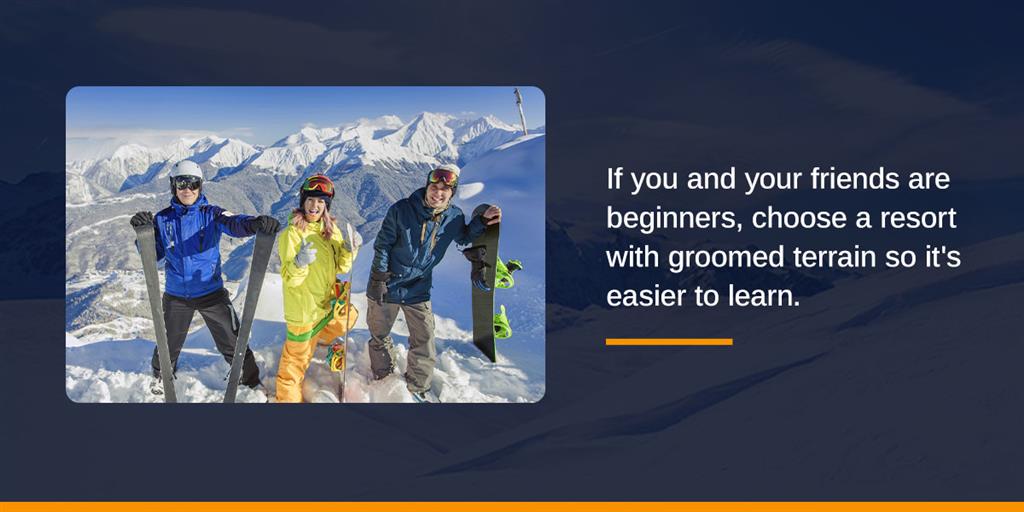
- Slope difficulty: Most resorts offer a range of runs for beginners to advanced skiers, but you'll still want to double-check. Some resorts focus on beginner-friendly slopes, while others prioritize providing challenges for experienced skiers.
- Resort amenities: Consider your amenity preferences when choosing a resort. Spas, restaurants, hot tubs, transportation, equipment rentals, lessons and extra activities are just a few examples.
- Family-friendliness: You'll need to look for a family-friendly resort if you plan to bring children. These resorts are designed with the family experience in mind and typically offer child care services, kid-friendly runs, beginner lessons and activities to keep your children entertained.
The Best Time to Plan a Ski Trip
The best time for your ski trip is ultimately up to you and your preferences. Consider the weather, the day of the week and whether promotions are available.
Ski Season
The snowy season in Pennsylvania depends on the year but is typically between December and March — though you may notice flurries before and after these months. The ski season follows this time frame since ski resorts need snow unless they have powder-making abilities.
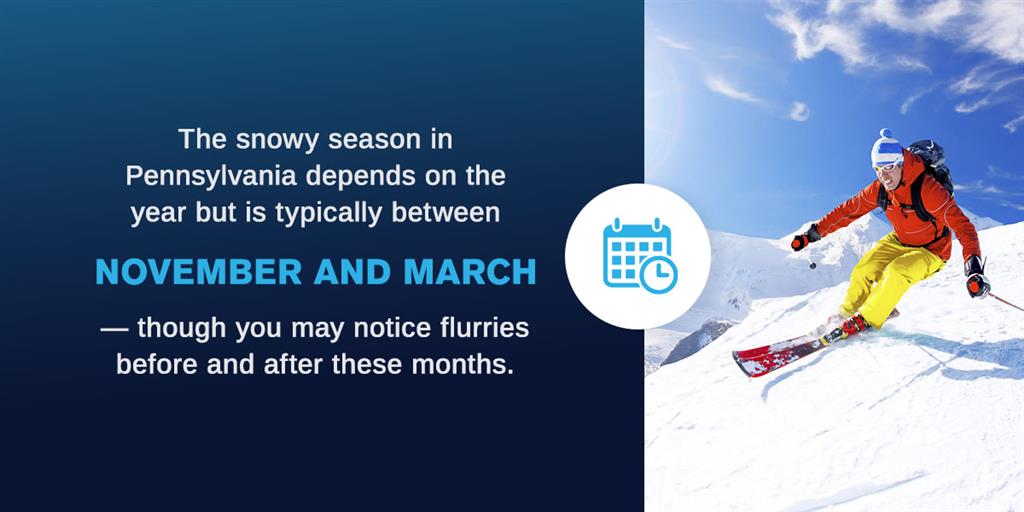
The holiday season is especially busy, and it might be more expensive to head to the slopes in December or early January. Many students also flock to the slopes for spring break, so there could be crowds when the closest colleges are on break. You might have more success with fewer crowds and reduced prices in February and March when the sun comes back and the holidays are over — as long as you avoid spring break weekends. However, there may be less snow closer to April, so keep an eye on the weather reports and pack your sunblock!
Weekends vs. Weekdays
Weekdays are typically less busy than weekends. Unless there is a holiday during the week or the week falls within peak season, plan your trip for a weekday if you want to save costs and encounter fewer lines.
Deals and Promotions
If you're looking to get a good price for your ski trip, it's best to book everything in advance, including your lodging, flights, rental cars, lift tickets, passes and lessons. Many ski resorts offer discounts when you book early or before the ski season starts, and you'll usually pay more for late bookings.
Sometimes, resorts offer bundle deals when you book lessons, accommodation and lift tickets together. You may also receive a discount for booking multiple days, and if you're planning to visit the slopes multiple times throughout the season, a season pass can save you money in the long run. Additionally, at the start and end of ski season, resorts might offer discounts since there are fewer people and possibly less snow.
Packing for Your Ski Trip
Now that you've booked your trip, it's time to pack! We've created a ski trip packing checklist for both equipment and clothing so you know exactly what to take:
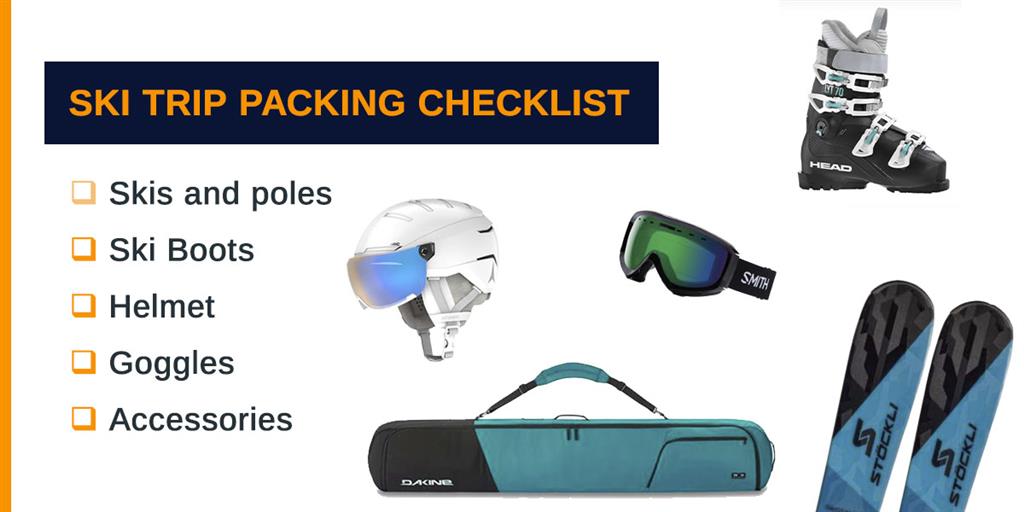
- Skis and poles: Of course, the most important gear for your ski trip are the skis and ski poles. Choose your skis and poles based on your skill level, build, preferred terrain type and snow level. We have an in-depth guide for buying the perfect skis if you need more information.
- Ski Boots: Next up, you'll want to pick up some boots to attach yourself to the skis and keep your feet warm. Boots have different levels of flex and features to choose from. What you choose should be based on your skill level and how you like to ski. Don't forget to account for your ski socks when picking your fit.
- Helmet: While you're there to have fun, you also want to stay safe while skiing. A helmet will be your best defense against head injuries, and it'll help keep your head warm.
- Goggles: Protect your eyes from wind, rain and glare with a good pair of goggles. Some even have anti-fog coatings that keep your goggles clear at all times.
- Accessories: Boot warmers, sunscreen, medical kits, lift pass holders, ski bags and stomp pads are just a few examples of ski accessories that may help you on your trip.
When selecting which equipment and accessories you need, it's crucial that you factor in what type of skiing you'll be doing. For example, if you're planning a backcountry ski trip where you'll ski in the snowy wilderness outside of resorts, you'll need different equipment than if you're just downhill skiing — the most familiar type of skiing where you glide down a groomed slope. Discover the best ski equipment brands for more info!
Renting vs. Buying Ski Equipment
Should you rent or purchase ski gear? Well, it depends on you! Renting ski equipment is a great option for beginners and people who don't ski too often, as some ski gear can be a large investment. When you're first starting out, renting helps you get a feel for your preferences and allows you to try out different brands before making a purchase. If skiing is more of a hobby or infrequent holiday activity, you could save some money by renting equipment when you need it.
Owning equipment, however, allows you to pick the perfect pieces for your needs. And if you're going to ski regularly, it'll be more convenient to have your own equipment — it might even cost less than renting it every time. Seasoned skiers may also prefer a specific brand and fit that resorts may not have available. Purchasing equipment can also save you time at the resort. You won't have to wait in lines to get your rental equipment and can head straight to the slopes upon arrival.
Another option is renting skis and poles and purchasing a helmet, boots and goggles. Boots are a great place to start when investing in your own equipment!
What Clothes to Wear on a Ski Trip
It gets cold out there, but with the right clothes, you'll stay warm and dry — even if you take a tumble! For your trip, pack the following:
- Base layer: To stay warm and dry, you'll need a tight-fitting shirt and leggings specifically designed to wick away moisture and trap heat. We have a guide all about base layers if you want to learn more.
- Mid-layer: When it's extra cold, a mid-layer — consisting of a sweater or fleece — will provide added warmth.
- Outerwear: To protect you from the wind and keep you from getting cold and wet, you'll need a high-quality, waterproof ski jacket and pants. You can buy a shell jacket that has one layer or one that has a built-in insulation layer. Check out our ski jacket guide for more information.
- Ski socks: Your feet will get cold fast on the slopes, so you'll want to buy a good pair of socks made for skiing. Synthetic, moisture-wicking socks are best.
- Gloves: Keep your hands warm and dry with some flexible, waterproof gloves or mittens. Some even come with wrist straps so you can take them off easily and not lose them.
- Neck warmer: For those particularly cold days, a neck warmer will help protect your face and neck from the elements.
Take a look at some of the best ski apparel brands for more detailed advice.
More Top Ski Trip Tips
You're nearly ready for your ski adventure! Before you go, here are a few extra tips to ensure it's the best yet:
- Travel insurance: Travel insurance can provide peace of mind if you're nervous about flight cancellations or want to have coverage in case of a medical situation.
- Ideal ski trip length: How many days you plan for your ski trip ultimately depends on your fitness levels and how much you want to ski. One or two days is usually sufficient, but if you want to stay a full week to try out all the slopes, incorporate a few rest days.
- Ski lessons: If you're planning a ski trip for beginners or visiting a new resort, it's beneficial to take ski lessons. Professionals will teach you how to stop and stay safe and give specific advice for their trails.
- Food recommendations: Skiing is quite tiring when you've been at it for a few hours. Pack some nonperishable snacks in your jacket pocket to stay nourished.
Get Everything You Need for a Ski Trip From Buckman's Ski and Snowboard Shops
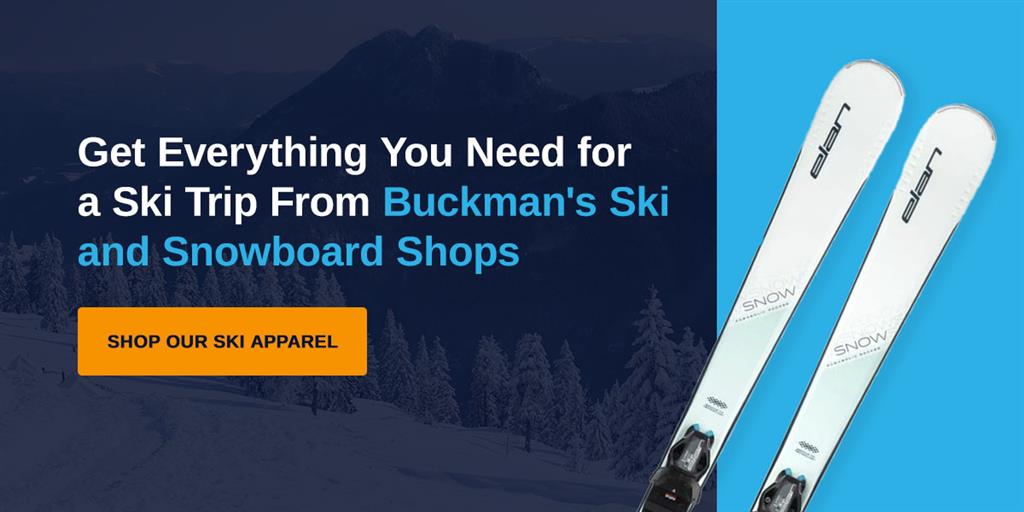
Buckman's Ski and Snowboard Shops is a family-owned and operated ski shop that's been selling the best ski brands since 1971. We share your passion for skiing and stock everything you need for an unforgettable ski trip experience.
Visit us at one of our seven store locations in Eastern Pennsylvania or browse our ski equipment and apparel online. We stock a wide range of skis, ski poles, ski boots, helmets, goggles, clothing and more. Check out our pre-trip checklist for a comprehensive list of products you may need.
We also offer ski rentals if you're not ready to make a purchase. If you need any advice on choosing a product, reach out to us via our contact form or visit a store — our experienced team is happy to help you choose the perfect gear and clothing. Happy skiing!
Categories:
Ski equipment
|
Ski & Snowboarding Tips
|
Ski & Snowboard Destinations
Tagged: ski, snowboard, ski and snowboard equipment, ski rentals, ski rentals near me, seasonal ski rentals